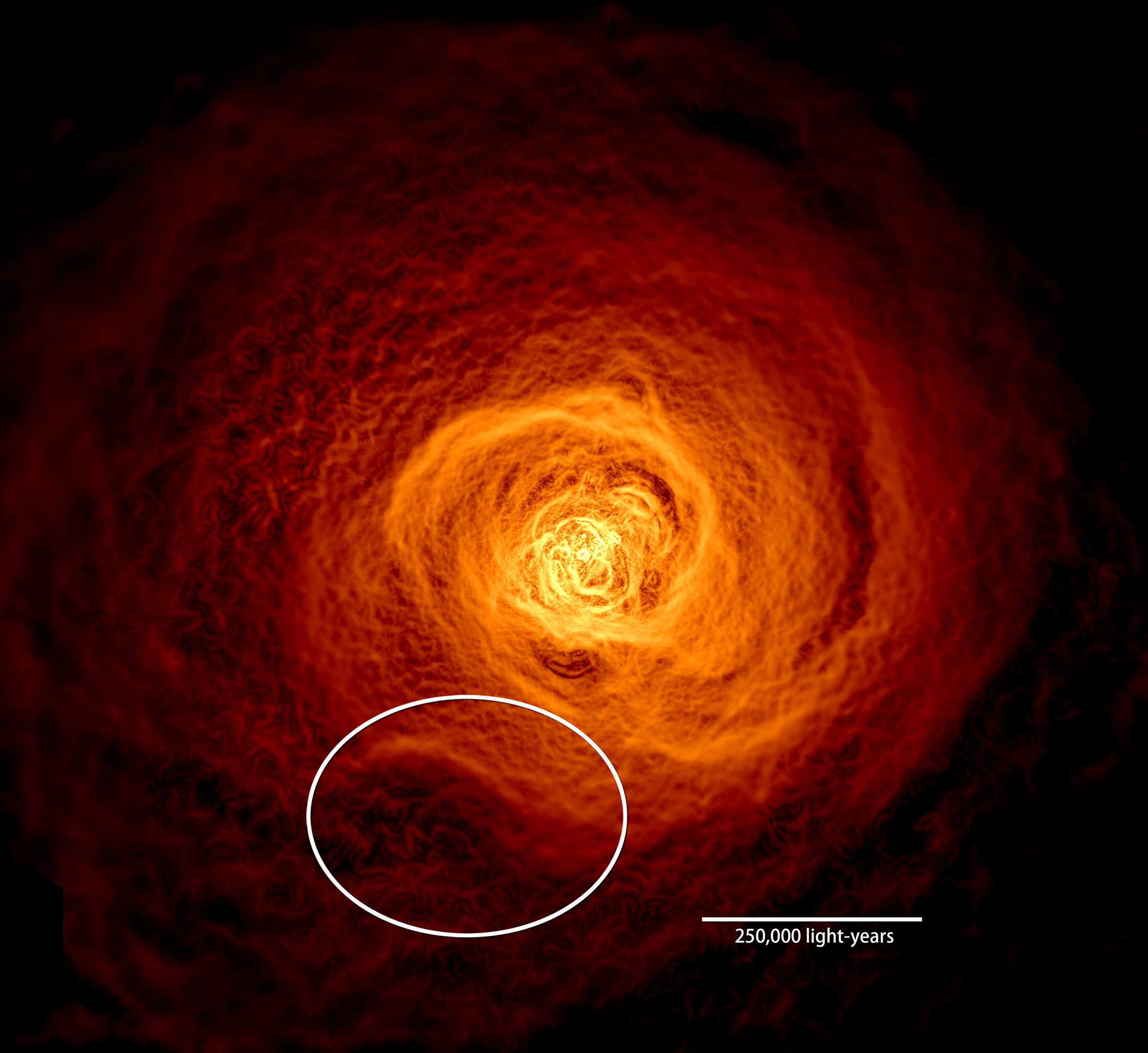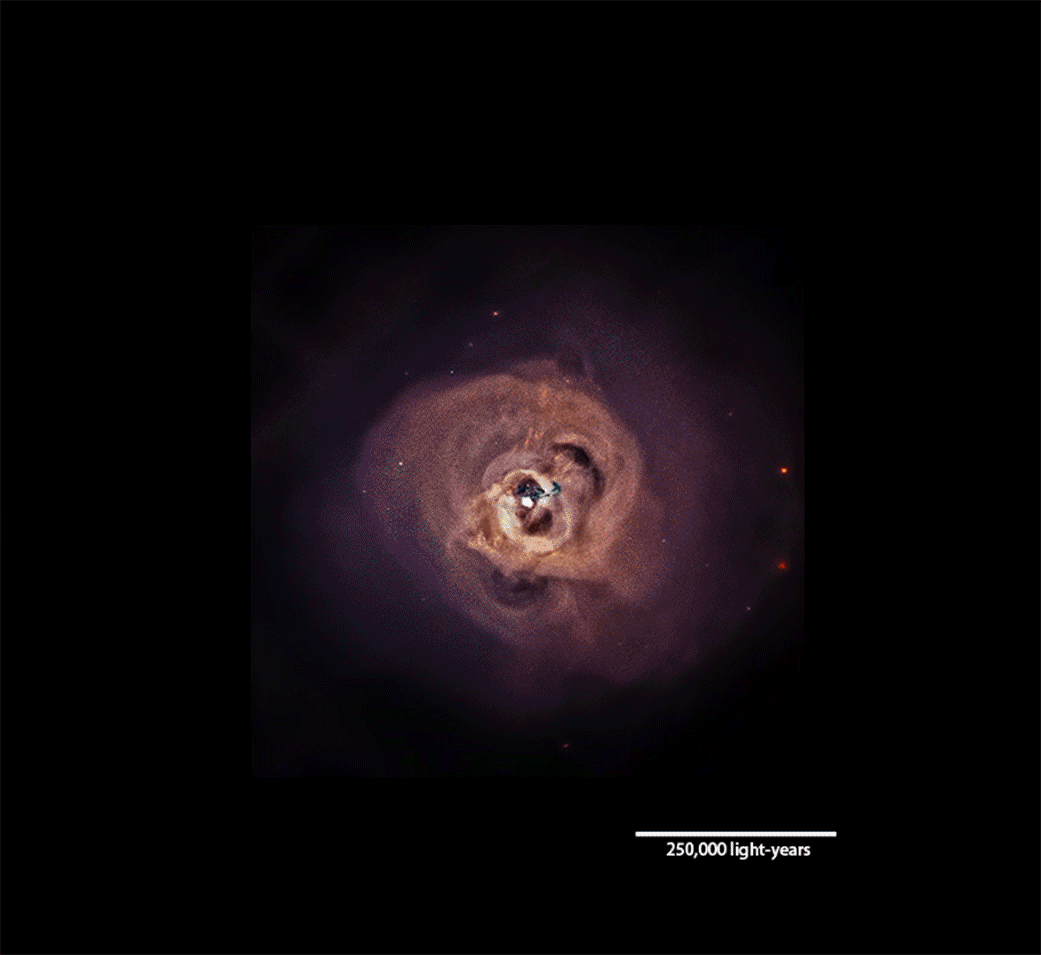Gigantic X-Ray Tsunami Rolls Through Galaxy Cluster (Video, Photos)

A wave of hot gas twice as wide as the Milky Way galaxy roils the nearby Perseus galaxy cluster, a new study indicates.
The wave, which measures 200,000 light-years across, likely formed billions of years ago, after a neighboring cluster clipped Perseus, researchers said. You can watch the monster wave roll in this awesome NASA video.
"The wave we've identified is associated with the flyby of a smaller cluster, which shows that the merger activity that produced these giant structures is still ongoing," lead author Stephen Walker, of NASA's Goddard Space Flight Center in Greenbelt, Maryland, said in a statement. ['Smashing' Galaxy Clusters Release 'Amazing Amounts of Energy' (Video)]
Galaxy clusters are the largest gravitationally bound structures in the universe. For example, Perseus — which lies 240 million light-years away from Earth, in the constellation of the same name — spans a vast 11 million light-years.
Most of the observable matter within galaxy clusters is superheated gas that glows in X-ray wavelengths, study team members said. Observations by NASA's Chandra X-ray Observatory and other instruments have revealed many interesting formations in Perseus' glowing gas, including an odd, 200,000-light-year-long concave feature dubbed "the bay."
The bay generates no emissions, so — unlike some other features in the massive gas field — its origins don't trace back to activity of the supermassive black hole at the core of Perseus' central galaxy, NGC 1275, study team members said. And the bay's shape doesn't match those predicted by computer models that simulate normal gas sloshing, the scientists added.
So, the researchers re-analyzed Chandra images of the bay, filtering them to highlight edges and other important details. Then, the scientists compared these enhanced observations to computer simulations of merging galaxy clusters performed by astrophysicist John ZuHone, of the Harvard-Smithsonian Center for Astrophysics in Cambridge, Massachusetts.
Get the Space.com Newsletter
Breaking space news, the latest updates on rocket launches, skywatching events and more!
"Galaxy cluster mergers represent the latest stage of structure formation in the cosmos," said ZuHone, who's not a member of the new study's team. (His simulations are available to other researchers in an online catalog.)
"Hydrodynamic simulations of merging clusters allow us to produce features in the hot gas and tune physical parameters, such as the magnetic field," ZuHone said in the same statement. "Then we can attempt to match the detailed characteristics of the structures we observe in X-rays."
Such comparative work led the researchers to identify a likely birth scenario for the bay. Long ago, Perseus' gas had settled into two separate components: an interior "cold" region with temperatures around 54 million degrees Fahrenheit (30 million degrees Celsius) and a surrounding area three times hotter, the idea goes.
Then, a smaller cluster about 1,000 times more massive than the Milky Way galaxy grazed Perseus, coming within 650,000 light-years or so of its core, researchers said. This near miss roiled Perseus' gas significantly, generating a spiral that expanded outward from the "cold" interior region.

About 2.5 billion years after the cluster flyby, this spiral reached 500,000 light-years from Perseus' center and began producing huge waves in the cluster's outer reaches. These features are basically enormous versions of "Kelvin-Helmholtz waves," which appear at the interface of two fluids that are moving at different velocities, the researchers said.
"We think the bay feature we see in Perseus is part of a Kelvin-Helmholtz wave, perhaps the largest one yet identified, that formed in much the same way as the simulation shows," Walker said. "We have also identified similar features in two other galaxy clusters, Centaurus and Abell 1795."
The new study will appear in the June 2017 issue of the journal Monthly Notices of the Royal Astronomical Society.
Follow Mike Wall on Twitter @michaeldwall and Google+. Follow us @Spacedotcom, Facebook or Google+. Originally published on Space.com.
Join our Space Forums to keep talking space on the latest missions, night sky and more! And if you have a news tip, correction or comment, let us know at: community@space.com.

Michael Wall is a Senior Space Writer with Space.com and joined the team in 2010. He primarily covers exoplanets, spaceflight and military space, but has been known to dabble in the space art beat. His book about the search for alien life, "Out There," was published on Nov. 13, 2018. Before becoming a science writer, Michael worked as a herpetologist and wildlife biologist. He has a Ph.D. in evolutionary biology from the University of Sydney, Australia, a bachelor's degree from the University of Arizona, and a graduate certificate in science writing from the University of California, Santa Cruz. To find out what his latest project is, you can follow Michael on Twitter.